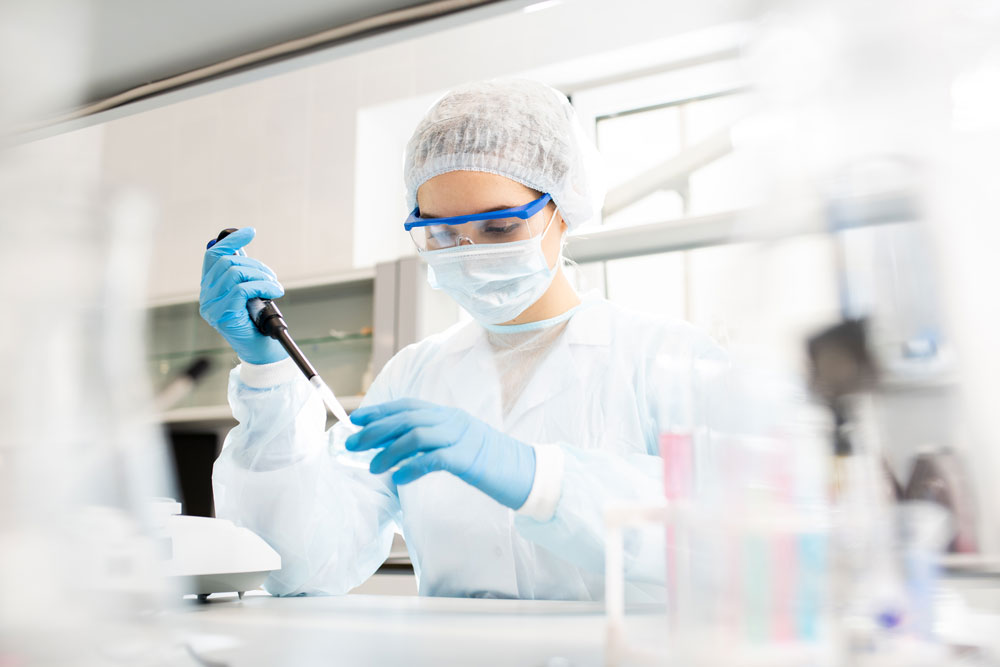What Is A Laboratory Cleaning Procedure?
 CONTENTS
CONTENTS
- The importance of a clean laboratory
- Laboratory glassware cleaning procedure
- Laboratory bench cleaning procedure
- Equipment cleaning procedure
- Book your laboratory clean today
A thorough, properly executed laboratory cleaning procedure is essential to keep your lab in pristine condition. It is recommended you bring in laboratory cleaning specialists to take care of cleaning your lab so you can be sure it is always in a safe, clean condition.
We offer our laboratory cleaning services nationwide. Our technicians are health and safety compliant and can carry out a thorough clean of surfaces, glassware, and equipment (including delicate equipment). They can also decontaminate the entire environment.
Keep reading to learn more about laboratory cleaning procedures and why they are so important.
The importance of a clean laboratory
Maintaining a clean laboratory is crucial for the safety, efficiency, and accuracy of scientific work. Professional cleaning services ensure that laboratories meet the required standards for hygiene and organisation.
It ensures safety
A clean laboratory minimises the risk of accidents and contamination. Hazardous chemicals, biological materials, and sharp instruments are common in these environments. Proper cleaning reduces the likelihood of spills, exposure to dangerous substances, and other potential hazards.
It improves the accuracy of results
Cross-contamination can compromise research outcomes. A meticulously cleaned laboratory ensures that experiments are conducted in a controlled environment which is vital for achieving reliable results.
It promotes efficiency
An organised lab allows researchers to locate equipment and materials quickly. This can save staff time which they can dedicate to critical research activities.
It makes sure your lab complies with regulations
Laboratories must adhere to strict regulatory standards regarding cleanliness and safety. Regular professional cleaning helps fulfil these requirements, avoiding legal complications or fines.
The Health and Safety Executive provides detailed guidance on managing the risks associated with biological agents in laboratories which you can find here.
Laboratory glassware cleaning procedure
-
Initial rinse: The first step in cleaning lab glassware involves rinsing each piece with distilled water to remove any loose particles or residues. This preliminary action helps prevent scratching or etching of the surface during subsequent steps.
-
Detergent wash: Specialised detergents designed for lab use are then applied. These solutions effectively break down organic and inorganic substances without leaving harmful residues behind. It is crucial to follow manufacturer recommendations on dilution ratios to ensure optimal results.
-
Scrubbing and brushing: Stubborn deposits require gentle scrubbing with brushes specifically made for lab glassware. Using appropriate tools minimises the risk of damage while ensuring all surfaces are thoroughly cleaned.
-
Rinse again: After washing, it is essential to rinse each item several times with distilled water. This step removes any detergent residue which could interfere with future experiments if left unchecked.
-
Drying the glassware: Glassware must be dried carefully either by air drying on a clean rack or using an oven set at a controlled temperature recommended for laboratory instruments only. Proper drying techniques prevent moisture from affecting sensitive measurements in future uses.
-
Sterilisation (if required): In situations where sterility is paramount, further steps such as autoclaving may be necessary following cleaning and drying processes. Sterilisation methods vary depending on the type of experiment but are vital for preventing contamination.
Why it should be left to professional cleaners
Cleaning laboratory glassware is a complex process that requires precision and expertise. It involves removing chemical residues, contaminants, and organic matter without damaging the glassware itself. This task presents several challenges and is best left to specialist cleaners.
The primary challenge lies in the diverse nature of substances that come into contact with laboratory glassware. These can range from volatile organic compounds to highly corrosive chemicals, and each needs specific cleaning methods for safe chemical removal.
Additionally, some experiments may leave behind microscopic residues invisible to the naked eye but capable of interfering with future experiments.
Another significant challenge is preventing physical damage to the glassware during cleaning. Laboratory glassware such as beakers, flasks, and pipettes are often delicate and require careful handling to avoid scratches or breakages.
Professional cleaners possess both the knowledge and equipment necessary for effective laboratory glassware cleaning. They understand how different materials react with various cleaning agents and employ techniques that ensure thorough decontamination without damaging equipment. You can learn more about how to clean glassware in a laboratory in this blog.
Laboratory bench cleaning procedure
- Removing items from the benchtop: This includes equipment, chemicals, and any other materials used in experiments or processes. It is important to handle these items carefully to avoid breakage or spillage.
- Dusting and wiping down surfaces: Once the bench is cleared, any loose particles will need to be dusted off with a soft brush. The surface will then need to be cleaned with a disinfectant. The choice of disinfectant depends on the types of substances handled within the lab.
- Sterilisation: In labs where microbiological work takes place, sterilising surfaces after general cleaning is paramount. This might involve using specific chemical agents designed for sterilisation purposes or employing ultraviolet light devices.
- Rinsing and drying: After applying disinfectants and sterilising agents, thoroughly rinsing surfaces with distilled water prevents residue build-up from cleaning solutions. Ensuring complete dryness afterwards either through air drying or using clean absorbent towels minimises moisture accumulation that can promote microbial growth.
Why it should be left to professional cleaners
Laboratory benches come into contact with a wide variety of substances, some of which can be hazardous. This makes cleaning them not only a matter of hygiene but also safety. The presence of chemicals, biological materials, or even radioactive elements adds complexity to the cleaning process.
Another challenge lies in the material makeup of laboratory benches. Many are made from materials like stainless steel or epoxy resins that require specific care to avoid damage during cleaning.
The intricacies involved in properly cleaning laboratory benches mean this task should be left to professional cleaners. Professionals have access to specialised equipment and products designed for safe and effective lab bench cleansing without risking damage the surface or leaving harmful residues behind.
Moreover, professional cleaners are trained in handling hazardous substances safely and disposing of waste according to regulatory standards.
Equipment cleaning procedure
- Dismantling equipment: If possible, dismantling equipment before cleaning allows for a more thorough cleanse. Removing any detachable parts ensures that hidden areas where contaminants might accumulate are accessible.
- Choosing appropriate cleaners: Selecting the right cleaning agents is vital. The choice depends on both the material of the laboratory equipment and the nature of the contamination. For example, glassware may require different cleaners than plasticware or metal instruments.
- Cleaning process: The actual cleaning often involves scrubbing the equipment with brushes or sponges followed by rinsing to remove any residual cleaner. Specialised ultrasonic cleaners might be employed for delicate items requiring gentle handling.
- Sterilisation: After washing and drying, some lab equipment needs sterilisation which can be achieved through various methods like autoclaving, dry heat sterilisation, or chemical disinfectants.
- Rinsing and drying: Rinsing thoroughly after washing removes traces of detergent while drying prevents moisture-related issues such as rust formation on metal tools or microbial growth on other surfaces.
Why it should be left to professional cleaners
The main challenge in cleaning laboratory equipment lies in the diverse nature of the contaminants. These can range from volatile organic compounds to infectious agents, and each contaminant will require specific cleaning methods for safe removal. Moreover, many pieces of laboratory equipment are delicate and require careful handling to avoid damage during the cleaning process.
Another significant challenge is ensuring that all traces of contaminants are removed without compromising the integrity or functionality of the equipment. This necessitates a thorough understanding of both the chemistry involved in various residues left by experiments and the proper use of cleaning agents.
Additionally, laboratories often contain sensitive instruments that can be adversely affected by standard cleaning procedures. Expert knowledge about these instruments' maintenance needs is essential for preventing accidental damage while still achieving high levels of cleanliness.
Book your laboratory clean today
Our fully trained technicians are available 24/7, 365 days a year to deep clean your laboratory. They have been accredited by a wide range of organisations including SafeContractor, IOSH, and IPAF.
Get in touch today on 0208 066 0360 or enquiries@icecleaning.co.uk to find out more about our laboratory cleaning services.

Speak with me today,
I’m here to help
By asking you a few questions either via phone or email I can immediately provide a realistic estimation of the cost.

Why choose us?
- Cater to a wide variety of cleaning situations
- Nationwide coverage, available 24/7
- Cater to commercial and domestic clients
- Free survey provided prior to quotation
- Emergency response team
- Offer a bespoke service designed to suit all your needs
- All technicians hold professional health and safety qualifications, including BICSc, IOSH, Dewpoint Professional & Safe Contractor
We’re fully accredited
We place best practise, professional expertise and health and safety at the core of our business. We’re fully compliant with all legal obligations. You can view a list of our accreditations below, or visit our Health & Safety page for more information.











-RGB-small.1707319151.jpg)




















